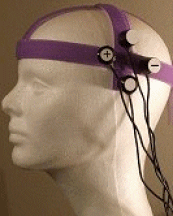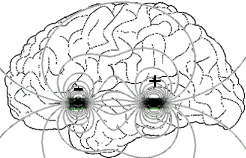The God Helmet: Junk psychiatric science: 2002 AD!
|
The God Helmet and "The God Spot |
Introduction:
- Psychiatrists are generally atheists who believe in evolution. They believe that the tendency for man to believe in God and worship a creator is just a trick the chemicals of the brain play on the neurons.
- Echoing Phrenology, they believe the exact place in the brain can be pinpointed where this "faith in a creator" and "spiritual experiences" originate from. They believe in what is called, "The God Spot". This is an area of the brain that makes Christians out of atheists. If they can just fix this malfunctioning part of the brain (because God doesn't exist) then they can rid man kind of this silly notion of a creator. The new world national anthem they envision is John Lennon's Imagine : "Imagine there's no Heaven. It's easy if you try. No hell below us. Above us only sky. Imagine all the people. Living for today. no religion too. Imagine all the people. Living life in peace."
- Psychiatrists, already adherents to evolution, believe the prevalence of religion in all cultures is because of a malfunctioning part of the brain and that evolution will one day fix! Well they believe they have found the God Spot of the brain and can therefore rid the world of religion, bring world peace... and make themselves rich!
- The God Helmet was invented in 2002 AD by psychologist Michael Persinger to induce a spiritual experience into the brain with magnetism.
- "But recently, materialistic explanations of religion and spirituality have gotten out of hand. Influenced by this materialistic prejudice, popular media jump at stories about the violence gene, the fat gene, the monogamy gene, the infidelity gene, and now, even a God gene! The argument goes like this: evolutionary psychologists attempt to explain human spirituality and belief in God by insisting that cave dwellers in the remote past who believed in a supernatural reality were more likely to pass on their genes than cave dwellers who didn't. Progress in genetics and neuroscience has encouraged some to look, quite seriously, for such a God gene, or else a God spot, module, factor, or switch in the human brain. By the time the amazing "God helmet" (a snowmobile helmet modified with solenoids that purportedly could stimulate subjects to experience God) in Sudbury, Canada, became a magnet for science journalists in the 1990s (the Decade of the Brain), materialism was just about passing beyond parody. Nonetheless, materialists continue to search for a God switch. Such comic diversions aside, there is no escaping the nonmaterialism of the human mind." (The Spiritual Brain, Mario Beauregard Ph.D., Neuroscientist, 2007, p xiv)
- Michael Persinger even began marketing a consumer version of the "God helmet".
- Even atheist Richard Dawkins embarrassed himself by flying 7000 miles to try it on and experience God for himself! He felt nothing. Richard Dawkins is supposed to be one of the smartest men on earth, yet actually tried on the God Helmet because he believes man only physical and that all spirituality is just chemical reactions in the brain! "For even though they knew God, they did not honor Him as God or give thanks, but they became futile in their speculations, and their foolish heart was darkened. Professing to be wise, they became fools, and exchanged the glory of the incorruptible God for an image in the form of corruptible man and of birds and four-footed animals and crawling creatures." Romans 1:21-23
- Neurological studies has confirmed that religious/spiritual/mystical experiences activate almost every area of the brain, not a single lobe of the brain as Phrenology influenced Psychiatrists believe.
A. religious/spiritual/mystical experiences activate almost the whole brain, not just in the "God spot"
- "Our findings demonstrate that there is no single "God spot" in the brain located in the temporal lobes. Rather our objective and subjective data suggest that RSMEs [religious/spiritual/mystical experiences] are complex and multidimensional and mediated by a number of brain regions normally implicated in perception, cognition, emotion, body representation, and self-consciousness." (The Spiritual Brain, Mario Beauregard Ph.D., Neuroscientist, 2007, p272)
- "We learned two valuable things from our studies. The results of the two studies, taken together (QEEG and fMRI), dispose of the notion that there is a God spot in the temporal lobes of the brain that can somehow "explain" RSMEs [religious/spiritual/mystical experiences]. The results of our fMRI and QEEG studies suggest that RSMEs are neurally instantiated by different brain regions involved in a variety of functions, such as self-consciousness, emotion, body representation, visual and motor imagery, and spiritual perception. This conclusion correlates well with subjects' descriptions of RSMEs as complex and multidimensional." (The Spiritual Brain, Mario Beauregard Ph.D., Neuroscientist, 2007, p274)
- "The main goal of this functional magnetic resonance imaging (fMRI) study was to identify the neural correlates of a mystical experience. The brain activity of Carmelite nuns was measured while they were subjectively in a state of union with God. This state was associated with significant loci of activation in the right medial orbitofrontal cortex, right middle temporal cortex, right inferior and superior parietal lobules, right caudate, left medial prefrontal cortex, left anterior cingulated cortex, left inferior parietal lobule, left insula, left caudate, and left brain stem. Other loci of activation were seen in the extra-striate visual cortex. These results suggest that mystical experiences are mediated by several brain regions and systems." (Mario Beauregard and V. Paquette, "Neural Correlates of a Mystical Experience in Carmelite Nuns," Neuroscience Letters 405 (2006): 186-90)
B. Examining the God Helmet:
"Michael Persinger was reported to finance most of his research in this area himself, through his work as a clinical psychologist." (The Spiritual Brain, Mario Beauregard Ph.D., Neuroscientist, 2007, p88 )
|
Signs (the movie, 2002 AD) Tin Foil Hat to protect brain from magnetism and radio frequency attempts at mind control from aliens from outer space was a concept borrowed from directly form modern current Psychiatry. In 2002 a psychologist invented the "God Helmet" that used magnetism to affect thought and feelings in the human brain. Although the materialist media loved and promoted it, it turned out to be a scam... just another example of the junk science of modern psychiatry. |
|
|
|
|
|
"God Helmet" Invented by junk science practitioner Michael Persinger (psychologist) to induce feeling into the brain with magnetism. |
|
|
|
|
|
"Shakti Helmet" |
|
|
Junk
science claims of the Shakti Helmet: |
|
|
|
|
|
"Q-Ray" or "IQ-Ray"? Actual claims: "Like acupuncture, yoga and tai-chi, Q-Ray is based on traditional Chinese medicine and is designed to optimize positive and negative energy sources to achieve a state of chi and promote feels of well-being." |
IQ-Ray is |
|
|
|
C. Gullible Richard Dawkins actually tried on the God Helmet:
- "It would be in Mr. Dawkins' interests to experience religion for the first time under Mr. Persinger's helmet. After all, this would prove that mystical visions at last could be controlled by science and no longer were just at the mercy of a supernatural entity." (Raj Persaud, "Test Aims to Link Holy Visions with Brain Disorder," London Daily Telegraph, March 24, 2003)
- The narrator was filling in time while waiting for Richard Dawkins to have a spiritual experience while wearing the God helmet: "Dr. Persinger's work suggests that different shapes of field and whether they're applied over the left or right temporal lobe can make a difference to whether the subject experiences god or not." (BBC Horizon, "God on the Brain," March 2003.)
- "The culture of popular science is one of unidirectional skepticism-that is, the skepticism runs only in one direction. It is skeptical of any idea that spirituality corresponds to something outside ourselves, but surprisingly gullible about any reductionist explanation for it." (The Spiritual Brain, Mario Beauregard Ph.D., Neuroscientist, 2007, p 91)
D. The God Helmet debunked by science:
- "An understated item in Nature News of December 2004 updated the story. A research team at Uppsala University in Sweden, headed by Pehr Granqvist, mirrored Persinger's experiment by testing eighty-nine undergraduate students, some of whom were exposed to the magnetic field and some of whom were not. Using Persinger's equipment, the Swedish researchers could not reproduce his key results. They attributed their findings to the fact that they "ensured that neither the participants nor the experimenters interacting with them had any idea who was being exposed to the magnetic fields, a 'double-blind' protocol." (The Spiritual Brain, Mario Beauregard Ph.D., Neuroscientist, 2007, p 95, see Khamsi, Electrical Brainstorms Busted as Source of Ghosts)
- "But the biggest single problem is this: Persinger offers no imaging data" to support his claims about what is happening in subjects' brains; rather, he relies on inference from the subjective reports of his subjects. Therefore, it is not possible to determine for certain that his targeted brain locations are in fact triggering (or failing to trigger) the experiences in the subjects or whether the magnetic stimulation is having its intended effect-or any effect at all. Given that neuroimaging techniques are now highly developed, it is interesting that so few of those who wrote about Persinger's work remarked on their absence." (The Spiritual Brain, Mario Beauregard Ph.D., Neuroscientist, 2007, p 89)
E. Psychiatrists believe religion is mere chemical reactions tricking us into faith in God:
- "The reasons for religion's tenacity have become much easier to identify over the past five years, thanks to advances in several modern fields of study, including a new branch of science known as neurotheology. It seems that our brain structure predisposes us to spiritual belief." (Patchen Barss, Me of Little Faith," Saturday Night, October 2005)
- "It may seem sacrilegious and presumptuous to reduce God to a few ornery synapses, but modern neuroscience isn't shy about defining our most sacred notions-love, joy, altruism, pity-as nothing more than static from our impressively large cerebrums. Persinger goes one step further. His work practically constitutes a Grand Unified Theory of the Otherworldly: He believes cerebral fritzing is responsible for almost anything one might describe as paranormal-aliens, heavenly apparitions, past-life sensations, near-death experiences, awareness of the soul, you name it." (Jack Hitt, "This Is Your Brain on God," Wired, November 1999)
- "Wouldn't the fact that all human cultures, no matter how isolated, have believed in the existence of a spiritual realm suggest that such a perception must constitute an inherent characteristic of our species, that is, a genetically inherited trait?" (Matthew Alper, The "God" Part of the Brain, 2001, p 67)"As scientists continue to unravel and decipher the contents of the human genome, perhaps there will come a time when we will have knowledge of precisely which genes are responsible or those parts of the brain that give rise to religiosity and spiritual consciousness. In order to accommodate this new field, the sciences may have to look toward a whole new discipline-a new geno-theology-for its answers." (Alper, "God" Part of the Brain, p 134, footnote)
- "By inventing a piece of wired-up headgear that induces "religious" experiences in the people who put it on, Sudbury neurotheologist Michael Persinger has shaken the foundations of faith and science." (Robert Hercz, "The God Helmet," Saturday Night, October 2002, p. 41)
- "Anyone who still doubts the brain's ability to generate religious experiences need only visit neuroscientist Michael Persinger at Laurentian University in the bleak nickel-mining town of Sudbury, Ontario. He claims almost anyone can meet God, just wearing his special helmet." (Bob Holmes, "In Search of God," New Scientist, April 21, 2001)
F. Leftist, anti-Christian Journalists are willing pawns:
- "Thus, the science journalist's tradition was skeptical of everything except materialism. Of that, no skepticism is permitted. Acting as successors to a traditional spiritual perspective that they assume is already discredited (without wondering how or why), many journalists fully expect that a gene, drug, neural circuit, or even the God helmet is truly an explanation of RSMEs [religious/spiritual/mystical experiences]. Only the details need filling in, it seems." (The Spiritual Brain, Mario Beauregard Ph.D., Neuroscientist, 2007, p 94)
- "The culture of popular science is one of unidirectional skepticism-that is, the skepticism runs only in one direction. It is skeptical of any idea that spirituality corresponds to something outside ourselves, but surprisingly gullible about any reductionist explanation for it." (The Spiritual Brain, Mario Beauregard Ph.D., Neuroscientist, 2007, p 91)
Conclusion:
- Neurological studies has confirmed that religious/spiritual/mystical experiences activate almost every area of the brain, not a single lobe of the brain as Phrenology influenced Psychiatrists believe.
- There is no single place in the brain where faith in God is generated by malfunctioning chemicals that trick us into believing in a God.
- The God Spot and the God Helmet are just two examples of how viciously anti-Christian modern psychiatry can be. It also shows them to be elitist snobs who believe they are "better adjusted" and "better than Christians" because they are atheists. They look down on Christians and view their faith as a mistake in evolution.
By Steve Rudd: Contact the author for comments, input or corrections.
Send us your story about your experience with modern Psychiatry





